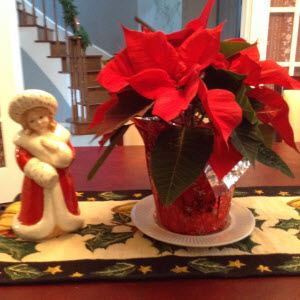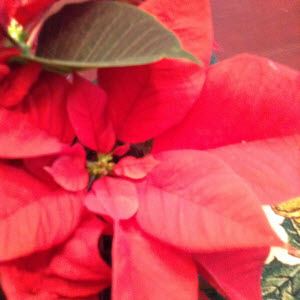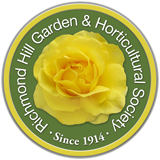Your Christmas or Holiday Poinsettia from December should still be blooming as long as you keep watering it. And if you follow a few simple guidelines, it can be kept for many years to come. The plant relies of three things – correct levels or amounts of light, temperature, and water.
 WINTER: While the Poinsettia is in bloom, keep it looking it best by placing it in a well-lit room, with as much indirect sunlight as possible. This blooming period (coloured bracts i.e., the leaves that change color depending on light exposure.) typically lasts from mid-November to late April. It is a little fussy about temperature. You should keep it at normal room temperature, but not above 20°C (68°F). Seems low but when my son is here, that’s his ideal house temperature year-round. And I can always wear a sweater. Nighttime temperatures of 16 to 17°C are best. Too much heat will shorten the blooming period. Poinsettias are sensitive to extreme temperatures (below 10°C and over 30°C). Avoid placing your plant too close to any heat source -i.e., not hear a furnace register, or on top of a PVR or television. Of course, my cat is always on top of those anyway, blocking the heat. Also keep it away from cold drafts. Watering should be done when the soil is dry to the touch. Use lukewarm water but soak the soil. If there is a dish under the plant which can get water to the plant roots, don’t leave any water standing in the dish as overwatering can cause root rot. And allow the soil to dry before you water again. The good news: there is no need to fertilize your poinsettia while it is in bloom. The length of blooming does vary by the variety (think colour) of your plant. After that time, its bracts will gradually lose their colour.
WINTER: While the Poinsettia is in bloom, keep it looking it best by placing it in a well-lit room, with as much indirect sunlight as possible. This blooming period (coloured bracts i.e., the leaves that change color depending on light exposure.) typically lasts from mid-November to late April. It is a little fussy about temperature. You should keep it at normal room temperature, but not above 20°C (68°F). Seems low but when my son is here, that’s his ideal house temperature year-round. And I can always wear a sweater. Nighttime temperatures of 16 to 17°C are best. Too much heat will shorten the blooming period. Poinsettias are sensitive to extreme temperatures (below 10°C and over 30°C). Avoid placing your plant too close to any heat source -i.e., not hear a furnace register, or on top of a PVR or television. Of course, my cat is always on top of those anyway, blocking the heat. Also keep it away from cold drafts. Watering should be done when the soil is dry to the touch. Use lukewarm water but soak the soil. If there is a dish under the plant which can get water to the plant roots, don’t leave any water standing in the dish as overwatering can cause root rot. And allow the soil to dry before you water again. The good news: there is no need to fertilize your poinsettia while it is in bloom. The length of blooming does vary by the variety (think colour) of your plant. After that time, its bracts will gradually lose their colour.
SPRING: After blooming ends around the end of April, the vegetative growth period begins and lasts until mid June. To help it through this stage of its life cycle, keep the plant in bright light or filtered sunlight at 20°C. In late April, you need to prune your poinsettia, cutting all the stems back by one third. For a more compact plant, keep only two or three leaves on each stem. Be sure to mist the plant with water to limit the seepage of white sap (aka latex) and prevent it from drying out. Note that the latex of a poinsettia can cause irritations to the skin or eyes, so it's best to avoid getting on yourself or your pets. After pruning, water only often enough to prevent the soil from drying out completely. This is also the time to repot the plant in an aerated, well-drained medium. You can use a ready-mixed commercial substrate or blend your own, using equal parts potting soil, perlite and peat moss. It is also time to change how you fertilize the plant once new shoots form, apply a soluble fertilizer, such as one labelled 20-20-20, once a month. Cuttings may be started from May to July. Cut the existing stems back to allow new growth to develop. Keep the parent plants warm, consistently moist, and in a bright location to produce useful cuttings. Once the new stems have grown at least 4 inches, you can begin taking cuttings. The cuttings should be between 3 to 4 inches long with 2 to 3 mature leaves. Each of these can be grown into a new plant.
SUMMER: Growing time is July and August, aka the Active Vegetative state. It is the time to ready the plant for flowering again. Prune the plant again in late July or early August, or pinch back the ends of the stems (leaving three or four leaves per stem) to encourage bushy, compact growth. After pruning, a temperature of 20°C to 24°C is ideal. Never pinch a plant back after early September if you want it to rebloom. Keep the plant in sunlight. Once the risk of frost is past (temperatures remain above 13°C), you can take the plant outside for the summer. But do this gradually. At first take it to a semi-shaded or sunny spot for a few hours. Each day you can extend its outdoors living. But if you can’t move it outdoors, then place it in your home where it will get as much light, even full sun, as possible. As it grows and new leaves appear, increase the frequency of fertilizing (every two weeks) to promote vigorous growth. As temperatures start to get below 20°C, you’ll need to bring the plant back indoors – again introduce it slowly (over a week) to the indoors. During the growing period after that, indoor temperatures of 20-24°C are good. After pruning, the poinsettia will require less water. Give it only enough to prevent the soil from drying out completely. Outside, especially in full sun, be sure not to let it wilt!
 FALL: Flower initiation (flowers and bracts form) from mid-September to mid-November. Once growth resumes, water only when the soil is slightly dry then soak the soil and allow the soil surface to dry out slightly again before the next watering. Please the plant in bright light in day (or filtered sunlight) with 14 consecutive hours of total darkness a day for eight to ten weeks. Keep the plant at 20ºC and once tracts are completely covered keep it at a lower temperature if possible, of 15-18°C to intensify the colour. Use a Soluble fertilizer (20-20-20) every two weeks. But in early November switch to a fertilizer that is 15-15-20 to further help with bloom formation. No need to prune nor repot during this time. And not a good time to take cuttings. By mid to late November, you can proudly display your Poinsettia for the Holiday season again. But you’ll know it is an attractive plant during all its life cycles!
FALL: Flower initiation (flowers and bracts form) from mid-September to mid-November. Once growth resumes, water only when the soil is slightly dry then soak the soil and allow the soil surface to dry out slightly again before the next watering. Please the plant in bright light in day (or filtered sunlight) with 14 consecutive hours of total darkness a day for eight to ten weeks. Keep the plant at 20ºC and once tracts are completely covered keep it at a lower temperature if possible, of 15-18°C to intensify the colour. Use a Soluble fertilizer (20-20-20) every two weeks. But in early November switch to a fertilizer that is 15-15-20 to further help with bloom formation. No need to prune nor repot during this time. And not a good time to take cuttings. By mid to late November, you can proudly display your Poinsettia for the Holiday season again. But you’ll know it is an attractive plant during all its life cycles!
Notes
Fertilizer: Poinsettias like a fertilizer with a smaller amount of phosphorus. Look for one where the second number is lower than the other two. Fertilizers are rated N-P-K. So, one labelled 17-5-19 or 20-10-20 is good. One that is 20-20-20 as this article states may be used as it is easier to find. Always follow the directions on the label.
Impact of eating Poinsettias: Poinsettias aren't poisonous to humans. Ingesting many leaves would cause some stomach discomfort (as with eating many other non-food items). If leaves or stems are eaten, rinse the mouth with water. The sap can be a skin irritant so wash the affected area with soap and water after contact. As with any plant or material, if you experience a severe reaction of any kind, seek medical help promptly. For you pet: As with humans, the Poinsettia leave’s sap can also irritate your dog or cat's mouth and esophagus. If ingested, your pet may experience nausea or vomiting. If your pet is willing to drink extra water, this is a good time.
Submitted by Doreen Coyne, a member of Richmond Hill Garden & Horticultural Society



